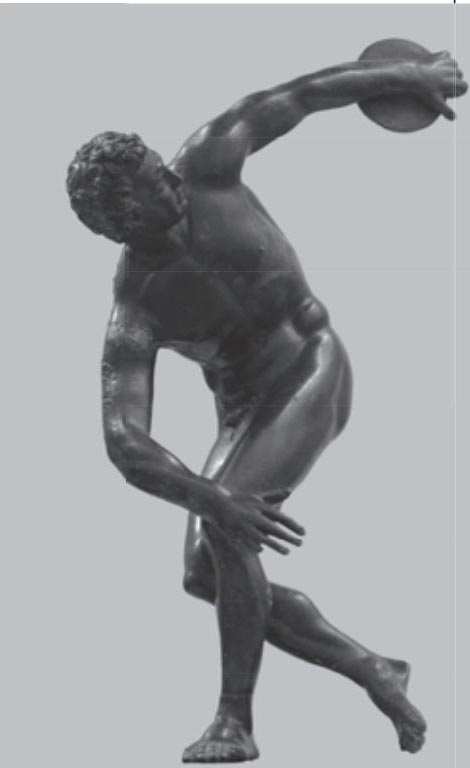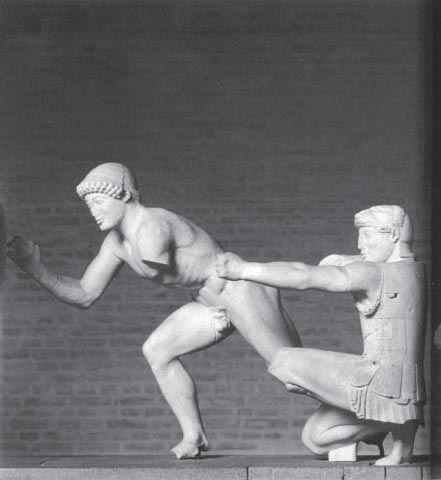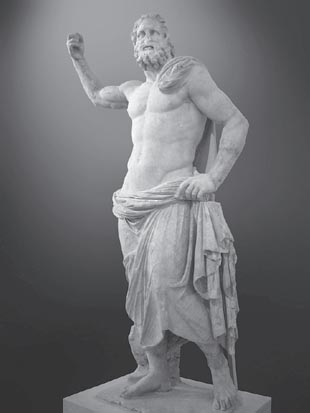





Ancient Greek sculpture mainly serves religious purposes. Each city has its own god and their deities could still be seen in the remains of the temples today. The Greek legends and mythology are also an important source of inspiration. People's daily lives features prominently in sculpture such as sport conventions, warriors, women taking care of her children and the mourner in front of a grave. Nudity appears constantly in Greek sculpture.The incessant wars and devotion for sports make the Athenians believe that naked men or women in good shape are a eulogy to the beauty of health, power and beauty. As a result, they were not reluctant to portray themselves in nakedness. Ancient Greeks used lime, marble, bronze, pottery, wood, gold and ivory to make sculptures, but only those made by stone have survived.Today's artists have recreated many of the extinct works according to texts and other literature so that we are able to appreciate the art from thousands of years ago in museums.

古希腊几何时期的陶艺品

古希腊雕塑服务于宗教目的,每个城邦都有自己的保护神,神庙中的许多神像今天仍然可见。丰富多彩的古希腊神话故事也是雕刻的重要题材,时代风俗和人们的日常生活,如运动竞技、勇士战斗、照看儿童的妇女和墓碑前的哀悼者也是雕塑的内容。古希腊雕刻喜爱以裸体为主,这与当时战争不断和体育风气盛行大有关系。古希腊人认为,身体健康、擅长运动的裸体男女是在展示一种美的风格。也正是因为这种社会风气,因此产生独特的审美观,导致古希腊人时常采用裸体的形式来制作雕刻作品。希腊雕刻的主要材料有石灰石、大理石、青铜、陶土、木头、黄金和象牙,但是仅有石雕幸存下来。今天艺术家们又根据文字和其他史料进行复制,才有了各大博物馆里丰富多彩的古希腊雕像。

古希腊雕塑

Ancient Greece, the origin of European civilization, was home to the greatest sculpture in history and the symbol of beauty in harmony and solemnity, setting up a model for the artists to come. During the span of one thousand years from 12 B.C. to 1 B.C., a plethora of Greek sculptors brought forth some of the most brilliant works in the world.
From 8 B.C. to 6 B.C., over two hundred slave polis emerged in Greece in the south of Europe, among which the strongest were Sparta and Athens.Greece was made up of the Greece peninsula and its affiliated islands and the western costal areas of the Minor Asia, where marble and clay, major raw materials of sculpture, were produced in abundance, creating a favorable environment for the form of art.
The Greek sculpture can be roughly divided into four periods. From the simple, erect human figures showing no sign of any personality, to the muchcelebrated athletes, and eventually to scenes taken from mythology with diversified movements, ideal physique characteristics and rich emotions, the ancient Greek sculpture has evolved to complexity and maturity.
古希腊,欧洲文明的源头,创造了世界上最伟大的雕塑艺术,体现了“美即和谐”的古希腊美学思想和“庄严恬静”的艺术境界,为后世树立了永久的典范。从公元前12世纪至公元1世纪,在长达1000多年的发展过程中,古希腊创造了世界上最伟大的雕塑艺术。
公元前8~前6世纪,欧洲南部的希腊出现了200多个奴隶制城邦国家,其中实力最强大的是斯巴达和雅典。希腊主要包括希腊半岛及其附近岛屿和小亚细亚西部沿海地区,那里盛产色泽优美的大理石和黏土,为希腊雕塑艺术的发展提供了良好的条件。

《掷铁饼者》

古希腊雕塑通常以古希腊神话作为创作源泉,古希腊神话体现了“神人同形同性”的观念,在这种观念支配下,艺术家们都按现实中的人的形象来塑造神。古希腊人爱好体育,运动员毫不介意脱掉衣服参加竞赛,也渴望健美的身体得到观众的赞美。因此对男女人体美的欣赏爱好便自然地在古希腊人的心目中培养起来,由此精心表现人体美、将理想和现实融为一体的人体雕塑艺术为后世树立了永久的典范。
古希腊雕塑大致可以分为四个时期,从直立、简单、看不出内心活动的人像,到反映希腊生活的运动塑像,和再现神话故事情节的动作复杂、曲线优美、个性鲜明的塑像,进化得越来越复杂、深刻。

几何时期的青铜马雕塑
The geometric style evolved during an early period of Greek art history. It was a dominant artistic style in ancient Greece during the years circa 1000 BCE to 700 BCE. The Greek city-state (polis) was formed, the Greek alphabet was developed, and new opportunities for trade and colonization were realized in cities founded along the coast of Asia Minor, in southern Italy, and in Sicily. With the development of the Greek city-states came the construction of large temples and sanctuaries dedicated to patron deities, which signaled the rise of state religion.
Greek geometric art was influenced by an earlier period, the Mycenaean style, that also created many representations of geometry in art. Geometric artists used every geometric shape they could think of: triangles, rows of dots, zigzag shapes and fish-bone shapes.Crosses and stars were found. Netshaped representations and the most well-known, the maze shape and checks, were common. The invention of the drawing compass was a tool of these sculptors, painters, jewelers and architects. Powerful bronze figurines and monumental clay vases manifest the clarity and order that are, perhaps, the most salient characteristics of Greek art.
Though the design of the geometric sculptures remained pristine, it manifested the ancient Greek philosophy of treating gods like human beings.The Greeks used realistic human form in their art and did not shun nudity. In their minds, the human bodies were beauty in itself and did not conflict with political, social, ethical or moral creeds.
The respect to human and the personification of gods were due to Greece's advanced political system in the slave society. Athens is one of the first known democracies. Each city of the Greek city-state of Athens, comprising the central city-state of Athens and the surrounding territory of Attica, ruled itself. It remains a unique and intriguing experiment in direct democracy, a political system in which the people do not elect representatives to vote on their behalf but vote on legislation and executive bills in their own right. Such a democratic system had inspired the entitlement and creativity of its people and was transformed into art. The major works in this period included ceramics, centaurs , Man and Centaur , etc.
公元前1000~前700年的几何时期是希腊最早的艺术时期。这一时期,希腊城邦开始建立,希腊字母发展成型,在小亚细亚沿海地区、意大利南部和西西里,贸易和殖民都有所发展。城市的发展推动了大型神庙的建设,每个城邦都供奉自己的庇护神。

几何时期的代表雕塑

古希腊艺术深受迈锡尼文化影响,创造了许多神像。艺术家们利用了他们所能想到的所有几何形状:三角、成串的圆点、之字形曲线、鱼骨形状等等,出现了十字和星形,网状、迷宫、棋盘形也很普遍。绘图用两脚规的发明极大地帮助了画家、珠宝制造者和建筑师的工作,大型的青铜雕像和黏土花瓶是这一时期常见的雕刻形式。
几何时期的雕塑虽然造型比较简单,但是可以看出希腊人“神人同形同性”的理念。在这种理念影响下,艺术家都是按照真实的人形象来雕刻,并大多以裸体风格来呈现作品。在他们眼中,单纯是一种“美”的凝视,借由专注的凝视,从政治的、社会的、伦理与道德的纷杂中净化为单纯的美的层次。
对人的尊重和对神的人性化,来自于古希腊开明的政治制度。古希腊是世界上最早实行民主制度的地区。它以城邦为单位,在城邦内部实行以公民大会为最高权力机关的奴隶制的民主政治,直接选举,即城邦的事物由全体自由人直接管理,而不是选举代表,成立议会来治理国家。这种主权在民与直接民主的制度,激发了每个公民的主人翁责任感和创造热情,这种对人的权力尊重也体现在艺术中,从而出现了许多以人为主题的作品和人性化的神。这一时期常见的作品有陶艺、半人马像、与半人马搏斗的宙斯,等等。

几何时期的陶罐雕刻

Greece was rich in marble. The marble sculptures during the archaic period (660B.C.-480B.C.) drew from Egyptian style and featured its typical posture: free-standing figures with a frontal stance and broad shoulders, the slightly forward left foot, the arms placed on the sides with curved elbows, the hands clenching or open. But Egyptian figures usually had a robe around the waist while the Greek ones went completely naked. Two types of thefigures prevailed: the standing nude youth, Kouros, and the standing draped girl Kore.
The Archaic smile was a smile frequently used by Greek Archaic sculptors, especially in the second quarter of the sixth century B.C., possibly to suggest that their subject was alive, and infused with a sense of wellbeing. To viewers habituated to realism, the smile is flat and quite unnatural looking, although it could be seen as a movement towards naturalism.
希腊的大理石蕴藏丰富,古风时期(公元前660年~前480年)的大理石雕刻明显借鉴了埃及艺术的成果,一些典型的人物姿态在希腊雕塑中反复出现,男青年正面立像遵循了埃及造型的正面率,人物肩膀宽阔,左脚微微向前,胳膊紧贴身体两侧,肘部微微弯曲,手或紧握或靠身躯放平。只是埃及像大多腰间有围布,而希腊雕塑则是完全裸体。男青年正面立像叫做库罗斯,女青年像被称为科莱。
古风时期的雕像有一个共同特点,就是他们都带着同一种笑容,叫做“古风微笑”,尤其是在公元前6世纪。这种笑容可能是用来增加人物的生命力的,对于看过现实主义作品的人来说,虽然这种微笑试图使人更加自然,但是却显得非常苍白平淡而做作。

克莱雕像
The classical period began from the later half of the 5th century B.C. at the end of the Greece-Persian War to 334 B.C. when Alexander the Great launched his eastern expansion. In 480 B.C., Greece won the long-lasting war again Persia and Athens became the leader among various cities in Greece, ushering in an unprecedented prosperity. At that moment, the Greek could skillfully use their knowledge on human body and create harmony among the movement, expression, garment and composition of the subject. The static archaic smile gradually disappeared to make way for the physical beauty. The shift took about 30 years, and a work in this regard was Poseidon.
Poseidon, god of the sea and earthquakes, was most at home in the depths of the Aegean where he lived in a sumptuous golden palace. When he became angry he would use his trident to create massive waves and floods.In this sculpture, Poseidon is in a position of throwing his trident. His arms stretch out, holding the weapon in his right hand, his left leg makes a huge step forward and his right leg rises a little bit, demonstrating his power and determination before he gets into a battle. Such kind of strength was exactly what led the Greek to victory in the war against the Persians.
An important part of the Greek national life was occupied by the Olympic Games.They were regarded as a sacred institution of the gods, and to contend in them was a religious consecration. None could enter them who had been guilty of dishonorable conduct or sacrilege.The prizes were wreaths of wild parsley, olive, and pine, having no intrinsic worth, but of priceless value to the recipients. Some of them would be made into sculptures.

“古风微笑”雕像
It would be readily seen that in statues of athletes the sculptor had greater freedom than in statues of the gods. The latter must be represented in dignified attitudes of repose, but the former would naturally be portrayed in some characteristic posture of action. It is so with the statue in our illustration called the Discobolus or Disk-thrower by Myron. The statue shows the disk-thrower at the moment immediately preceding the throw. He is bent down into the position for the throw, turning towards the hand that holds the disk, and all but bending on one knee, he seems as if he would straighten himself up at the throw. All the lines of the modeling indicate the tension of the sinews towards the contracted centre of the body, and the legs, neck, and shoulders tend towards the same point. When we walk around the statue, all the lines in the back and sides seem to lead towards that central point like the spiral contraction of a spring. It is by thus suggesting the concentration of energy on the part of the Discobolus that thefigure appears so full of life and action.

希腊竞技题材雕塑
|

海神《波塞冬》雕像 |
古典时期是公元前5世纪下半期至公元前334年希波战争结束至马其顿亚历山大大帝开始东侵的时期。公元前480年,希腊取得了旷日持久的希波战争的胜利,雅典也随之确立了在希腊各城邦中的领导地位,希腊进入了空前繁荣的时期。此时,希腊人能够熟练地运用人体结构的知识,人物雕像的动作、表情、衣饰及构图都更加接近真实的人。至此,静态的“古风微笑”逐渐消失,转而表现人的运动,这个过程大约经历了30年,代表作是海神《波塞冬》青铜雕像。
波塞冬住在爱琴海深处一个华丽的金色宫殿里,每当他发怒时,就会用他的三叉戟搅起狂风巨浪。这尊雕像以雄健开阔的动作塑造出海神投掷三叉戟的动态:双臂平衡地前后张开,右手握着三叉戟作投掷之势,左脚跨前一步,右脚稍微提起,全身重心落在两腿之间。这是一种临战姿势,给人以威严无比,大有“力拔山兮气盖世”的气概。这种精神状态正是希波战争中希腊人民英勇抗击侵略者的真实写照。
古希腊生活中一个重要的部分是奥林匹克运动,这个盛事被视为上天的旨意,只有对宗教虔诚的人才能参加这个盛事运动,如果曾经犯过法、做过亵渎圣物的行为的人,是没有资格参加的。奥林匹克最后的奖励是一圈由香菜叶、橄榄、松枝编织成的花环,没有什么实际的价值,但是对得奖的人来说这却是无上的荣耀。其中有些获奖者还会被制成雕塑,名垂青史。
与神的雕塑相比,动员的雕塑自由性要大得多。神无论怎样还是要端庄典雅,但是运动员的姿态就非常自然,如米隆的《掷铁饼者》。这尊雕塑展现了掷铁饼运动员在发力瞬间的动作,他弯下身去,身体偏向拿着铁饼的一方,双膝弯曲,似乎下一秒身体就因为发力而瞬间伸直。他身上肌肉的线条展现出他正铆足了劲,腿部、脖子和肩部的肌肉向同一个方向伸展。环顾雕像四面,你会发现所有的线条都指向一个中心点,就像压紧的弹簧一样。展现力量的集中,是《掷铁饼者》如此形象生动的原因。
Hellenization came after the reign of Alexander the Great, and lasted just a couple of centuries (330 B.C.–100 B.C.). Alexander the Great had basically conquered all of the world, from Minor Asia, Mesopotamian, to Persia, Egypt and Indian. His reign brought about the realization of the individual in the Greek culture. Thus art, architecture and cultural identification experienced an alteration.
Hellenistic sculptures were more realistic and natural. The Hellenistic realism expressed temporary emotional conditions, pain and suffering. The sculptors did emphasize religious and moral values, but took it further in a sense that the secular viewpoint became more important. Moreover, they were also concerned with scenes witnessed in daily life. The sculptures portrayed inner character, feelings and experiences. The underlying trend of this period was an attraction towards eroticism, violence, but above all to provide truthfulness.

《米洛斯的维纳斯》

The Aphrodite of Milos was made of marble and represents vivdly the goddess Venus (Aphrodite). Aphrodite was born from sea-foam, arose from the sea and came ashore on the island of Cyprus. As she walked along the beach, flowers sprang forth in her footsteps. The statue shows Aphrodite semi-nude and with a robe wrapped around her legs, representing a mixture of Classical and Hellenistic traits, which create a unique and alluring visual experience befitting the goddess of beauty and grace. The body's twisting pose and jagged, deeply carved drapery is indicative of Hellenistic styles, but the soft, flowing musculature is similar to the Praxitelean S-curve associated with Late Classical art. Today, the original stands in the Louvre Museum of Paris, where it continues to attract much attention.
Another masterpiece in the Hellenistic period is Laocoon and His Sons . The Trojan priest Laocoon, who spoke out God's will to save his people, and gets punished by God. The sculpture shows Laocoon and his two sons assailed by serpents. The serpents twist around him and try to bite his waist. He quickly darts back and holds the serpents in his arms. His muscles bulge up and his face disfigures because of the excruciating pain. The sculpture goes down history as one of the best works with a tragic theme in history.
希腊化时期从亚历山大大帝的连年征战征服了小亚细亚、美索不达米亚、波斯、埃及、直到印度河流域开始,持续了几个世纪,此期大大扩展了希腊的疆土,也给希腊文化带来了根本性的变化,雕塑作品日益倾向个人化和写实。

《拉奥孔与儿子们》

希腊化时期的雕塑更加现实、自然,更接近现代艺术表现痛苦和煎熬的风格。雕塑家脱离了为宗教和道德服务的古典美,而转向非神的、人性的创作,他们喜欢表现日常生活中的景象,展现人内心的喜怒哀乐。这一时期的雕塑倾向于表达性爱、暴力和人性最真实的一面。
《米洛斯的维纳斯》是一座大理石雕塑,表现了爱神维纳斯(希腊名为阿芙洛狄忒)的美。阿芙洛狄忒从泛着泡沫的海洋中降生,在塞浦路斯岛上登岸,她所到之处鲜花盛开。这座雕像刻画的是腿上围着长袍半裸维纳斯,是古典和希腊化风格的综合,极大地褒扬了爱神的魅力和优雅。她的身体扭转,皱褶分明的长袍,紧紧贴在她身上,这是明显的希腊化风格,但是柔韧的肌肉组织又似古典时期普拉克西特利斯喜欢用的S形曲线。今天,这座雕塑的原作放在巴黎的卢浮宫里,吸引着世界各地的游客。
希腊化时期的另一件伟大作品是《拉奥孔与儿子们》。特洛伊城的祭祀拉奥孔为救特洛伊的人民泄露天机而受到天神惩罚,在祭坛上,他和两个儿子被巨蛇缠绕,濒临死亡。两条巨蛇仅仅拆绕在他的胸腹,张嘴咬他的腰部,拉奥孔身体急剧地向后躲闪,两只手紧紧抓住巨蛇,在做生死搏斗。他的肌肉因为恐惧而拱起,脸因为剧痛而变形。这件作品将人物极度痛苦的情绪表现了出来,是历史上最伟大的悲剧雕塑之一。